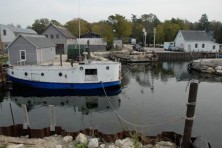Tree Enemies: Pests, disease, changed conditions and invasive species all threaten native forests
- Share
- Tweet
- Pin
- Share

A slide shown during a workshop depicted deciduous trees and dense undergrowth contrasted by the greenery of pines. The beauty of the forest image caused naturalist Coggin Heeringa to speak up.
“I said, ‘That’s just beautiful; that looks just like Crossroads,’” recalled Heeringa, who works for Crossroads at Big Creek.
Botanist Gary Fewless paused and looked at Heeringa.
“This is a photo of a forest that doesn’t know it’s dead yet,” he said.
The picture showed a forest floor overtaken by buckthorn. As it turns out, the invasive, nonnative shrub was also on the verge of destroying woodlands and meadows near Big Creek, on the east side of Sturgeon Bay.
“That was our wakeup call,” said Heeringa, who still has volunteers, staff members and interns cutting and killing buckthorn to revive and protect the 120-acre preserve.
Crossroads has made headway in its war on buckthorn, but where the shrub has taken root at various locations in the county, it shades out wildflowers and tree seedlings and saplings. And it’s just one member of an army of plants, diseases and conditions that threaten Door County’s trees.
Here’s a glimpse at some of those threats:
Long-term Flooding: For two years, high Lake Michigan water levels left water standing in wetlands and lowlands that had typically dried out for part of most years.

“A lot of trees can tolerate wet feet, like tamaracks, cedars and ash,” said Jake Schroeder, a Sturgeon Bay-based forester in charge of northeast Wisconsin for the Department of Natural Resources (DNR).
But unlike cypress in the South, most trees in Door County can’t tolerate having their roots and the base of the trunk submerged for months on end. Stressed trees are also more susceptible to tree-killing pests.
“We are seeing water go down,” Schroeder said, “and I think that will be good for our swamps.”
Emerald Ash Borer: Have you seen the D-shaped exit holes on the trunks of ash trees, or the more-obvious piles of shredded bark around ash trees?
They’re the work of the emerald ash borer, whose impact became more obvious countywide this year and will continue to spread. Despite public-service and ad campaigns against the practice, transporting firewood within the county has sped the spread of the borer, Schroeder said.
After wiping out trees in the Northeast and Michigan, it was first found on residential property in Fish Creek. In the fall of 2020, Door County officials had not seen many signs of ash borers at the tip of the peninsula or on Washington Island or Rock Island, but Schroeder said its arrival in those places is just a matter of time.
Conservation officials have seen minor successes through the release of parasitic wasps that attack ash borer larvae, but such efforts might merely “give ashes a little breathing room.”
Some trees with trunks smaller than four inches in diameter have survived long enough to produce seed. Like American elm trees that were decimated by Dutch elm disease, some young ash trees should continue to pop up for decades to come.

At Crossroads at Big Creek, Heeringa is seeing a comeback of wetland plants in low-lying areas where ash trees had died and fallen.
Beech Bark Disease: Two types of Neonectria fungi and an aphid-like, sap-feeding scale insect attack and kill beech trees.
This European disease has spread slowly since arriving in northeastern North America in 1920. It arrived in Michigan by 2004 and showed up around 2010 at Peninsula State Park in Door County, which is near the western edge of American beech trees’ natural range.
In an effort to slow the spread, the DNR continues massive cutting operations in portions of woods infested with emerald ash borer and beech bark disease in Potawatomi State Park. Somewhere between 1% and 5% of beech trees in plagued parts of North America have shown genetic resistance to beech bark disease, Schroeder said. An eventual 95% loss of big beech trees seems likely, but smaller trees are doing OK.
Land managers leave many dead trees standing so they can continue to provide food and shelter to native birds and organisms.
Colorado Blue Spruce in Decline: The branches of many Colorado blue spruce – a mainstay in parks and lawn landscapes – appear dead, and in many trees, the green and bluish needles are harder to find than brown needles or bare branches.
“Rhizosphaera needle cast has been hitting these spruces,” Schroeder said. In addition, Colorado blue spruce are native to sandy, rocky soil in Rocky Mountain states, and as they age, they become intolerant of saturated soil.
The pH of the soil in much of Door County is not ideal for many types of introduced pines, such as blue spruce and Scotch pine. Wet years have not been good for blue spruce, Scotch pine and white pines, which have had yellowish needles in some locations in recent months.
“It might even out if we have a dry year,” Schroeder said. As for nonnative spruce, Norway spruce have been thriving in Door County.
Invasive Plants: Buckthorn, honeysuckle and barberry top the list of nonnative shrubs that crowd out native tree seedlings and saplings. Although they’re notorious for outcompeting native wildflowers, invasive plants such as garlic mustard and Dane’s rocket can also dominate locations where young trees could grow.
The DNR continues to watch for other invaders that haven’t yet arrived in Door County. These include a destructive type of oak wilt that’s been found in central Wisconsin, as well as nonnative gypsy moths and Japanese beetles, which can defoliate and damage trees.




